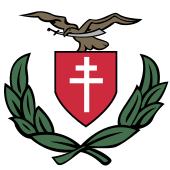Lajtabánság

Lajtabánság ( German Leithabanat or Leitha - Banschaft ) was an area in what is now Burgenland that was proclaimed as an independent, dictatorial area by Hungarian vigilante associations . It existed from leaving the Hungarian Army on October 4, 1921 until the occupation by the Austrian Armed Forces , which began on November 13, 1921 and was completed by the end of November. The area was officially handed over from Hungary to Austria on December 5, 1921.
history
Burgenland belonged to the Treaty of Trianon the Kingdom of Hungary (see History of Burgenland ). When Burgenland was to be handed over to Austria in accordance with the peace treaties of Trianon and Saint Germain at the end of August 1921 , this was prevented by military resistance from Hungarian irregulars who had penetrated from central Hungary, who repulsed the Austrian gendarmerie . Although the regular troops of Hungary had to evacuate Burgenland by order of the conference of ambassadors of the victorious powers of the First World War, the government had no influence on the irregulars, whose commander Pál Prónay proclaimed the "Republic of Lajtabánság" on October 4, 1921 in Felsőőr / Oberwart . The aim of Prónays, who also issued its own postage stamps, was to rejoin Hungary after a referendum.
A total of 79 postage stamps and six postage stamps were issued for western Hungary in 1921. No watermark was used. The responsible diocesan bishop set up a vicariate general for the area for which he appointed the dean of St. Michael near Güssing.
The “Lajtabánság Republic” did not last. On the one hand, the dispute increased between the "free royal electors", to which Prónay belonged, and the "Carlist", who supported the restoration attempts of the former Austrian emperor and Hungarian king Karl I , and on the other hand the Hungarian government exerted pressure to attack Burgenland vacate in order to avoid foreign policy sanctions from the victorious powers. The "operetta state" ended with the withdrawal of the irregulars on November 10, 1921 and the final entry of the Austrian gendarmerie.
Apart from a few stamps and two issues of an official gazette, there are no legacies of the Leithabanat. Documents were partly kept in the Hungarian State Archives, partly in the archives of the Leithabanat, which were destroyed in 1945. Pál Prónay found around 15 letters in the correspondence between Gyula Gömbös and the leadership council of Etelközi Szövetség . Individual letters are in the State Archives, the wording is only partially preserved because Prónay made copies of his memoirs (see the main article on the tradition ).
Aftermath
A separate room is dedicated to Lajtabánság and his dictator Pál Prónay in the Trianon Museum in Várpalota .
On October 3, 2010, supporters of Jobbik held a memorial ceremony for Lajtabánság in Oberwart , approved by the competent Austrian authorities , which led to a request from Green MP Karl Öllinger in the Austrian National Council.
literature
- Béla Bodó: Pál Prónay: Paramilitary Violence and Anti-Semitism in Hungary, 1919–1921 (= The Carl Beck Papers. No. 2101). Center for Russian & East European Studies, University of Pittsburgh , March 2011, doi : 10.5195 / cbp.2011.167 , p. 31 ff.
- Béla Bodó: Iván Héjjas. In: East Central Europe. Volume 37, No. 2–3, 2010, p. 247 ff.
- Józef Botlik: The Fate of Western Hungary 1918-1921. Buffalo undated , p. 160 ff, (PDF) (Original title: Nyugat-Magyarország sorsa 1918-1921. Vassilvágy, 2nd edition 2008).
- Lászlo Fogarassy: Paul Prónay's memories of the “Lajta-Banat”. In: Burgenland homeland sheets . 52nd year, Heft 1, Eisenstadt 1990, pp. 1-10 (German summary of his diary entries relating to the topic), PDF on ZOBODAT
- Andreas Moritsch: From ethnos to nationality: the national differentiation process using the example of selected places in Carinthia and Burgenland. Oldenbourg, Munich 1991, ISBN 3-486-55878-1 , p. 110 f.
Individual evidence
- ↑ August Ernst: History of Burgenland. History of the Austrian federal states. Verlag für Geschichte und Politik, Vienna 1991, ISBN 3-7028-0311-4 , p. 196.
- ↑ West Hungary. In: Phila-Lexikon , accessed on February 17, 2017. See Rüdiger Wurth: Postal History Aspects of German-West Hungary in connection with the transition from Hungarian to Austrian administration in 1921. In: Burgenländische Heimatblätter. Volume 53, 1991, pp. 1-22, PDF on ZOBODAT
- ↑ Gerald Schlag: Born out of rubble ... - Burgenland 1918–1921 (= Scientific papers from Burgenland . Volume 106). Burgenland Local History Museum, Eisenstadt 2001, p. 434, PDF on ZOBODAT
- ↑ Andreas Moritsch (Ed.): From Ethnos to Nationality. Oldenbourg, Munich 1991, ISBN 3-486-55878-1 , p. 111.
- ↑ August Ernst: History of Burgenland. History of the Austrian federal states. Verlag für Geschichte und Politik, Vienna 1991, ISBN 3-7028-0311-4 , p. 197.
- ↑ Fogarassy, memories , p. 1 and 4. In addition to the passages given in the main article, excerpts from Prónay's writings can also be found in Gerald Schlag: Born out of rubble ... - Burgenland 1918–1921 (= Scientific papers from Burgenland. Volume 106) . Burgenländisches Heimatmuseum, Eisenstadt 2001, p. 430 ff, PDF on ZOBODAT Katharina Tiwald: KeinFunkenLand (= Edition Lex Liszt. Volume 12). Oberwart 2014, ISBN 978-3-99016-076-3 .
- ^ Demonstration by Hungarian right-wing extremists in Oberwart. In: Parlament.gv.at , accessed on May 31, 2017.

